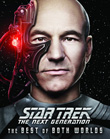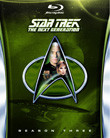A few weeks ago CBS invited TrekCore to talk with the CBS Digital team responsible for the wondrous restoration and remastering of Star Trek: The Next Generation in high definition. Craig Weiss and his team were very generous with their time and answered a huge number of questions, often very technical in nature. I hope you enjoy the resulting interview and leave with a greater understanding and appreciation for the monumental effort that this project represents, and of the wonderfully talented people who are working tirelessly behind-the-scenes to make it happen. Feel free, as usual, to leave comments and questions below.
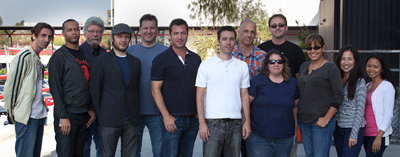
CBS Digital: TNG Remastered Interview, Part 4
Interviewed by Adam Walker for TrekCore.com
![]()
TrekCore: So, you mentioned Craig that you have two separate effects houses working on the show now. How does that affect the continuity of the effects shots – do you find that they are different from season to season?
Craig Weiss: I don’t think so. Really, Mike and Denise Okuda – who are the eyes and ears of the fans – are the ones who are overseeing the consistency of the look. They sit in on all of the reviews and approve all the shots because of their history with the franchise and the fanbase. It’s really Mike and Denise who keep the consistency from season to season historically accurate and what they feel is aesthetically important. That’s pretty much how we keep the consistency.
TrekCore: Do you collaborate at all with the other team, or is it independent?
Craig Weiss: It’s relatively independent. But we do collaborate on sharing elements and stuff. Sometimes we might have a film plate that they need and vice-versa, so we share that. But for the most part it’s their artists working on that season, and us here. We don’t have our guys over there and vice-versa, it’s pretty separate. It’s due to – it was a staggering schedule in terms of delivery – so there’s absolutely no way… we would have loved to have kept that here, but due to the schedule it was just impossible.
TrekCore: So at CBS Digital you’re working on the third season now?
Craig Weiss: Yes, we’re probably more than half way – three quarters of the way through the third season.
TrekCore: If I ask ‘What episode are you working on at the moment’, is that a redundant question? Are you working on multiple elements from different episodes at the same time?
Craig Weiss: Yes. What happens is – everything gets transferred. We do work in a kind of linear fashion, but we have multiple episodes up in the air at the same time based on – just to keep the work flow going, as we might be waiting on one episode for elements, we’ll jump to the next one. We have five-six episodes up in the air at any one time.
TrekCore: Are you finding Season 3 more technically different than the first season?
Eric Bruno: Yes! They definitely upped their game with this season. Many more ships, more complex ship moves, more complex alien transporters, more complex alien phasers, lasers, explosions – you name it. They hit their stride in Season 3 as far as that’s concerned, and they were definitely pushing the envelope. While Season 3 may have a smaller number of visual effects shots compared to Season 1, the complexity is such that it’s taking us more time to finish them because they were top of their game back then.
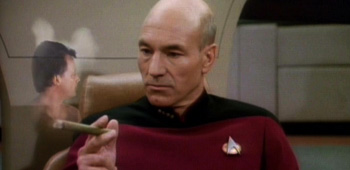
Some of the smallest elements can be taken for granted, such as Q’s floating head in this famous scene from ‘Déjà Q‘. It’s Sarah Paul’s job to track down every piece of film which often proves difficult if it is so small.
TrekCore: For Sarah – even the smallest elements that we may take for granted… I heard it mentioned you had trouble locating the image of Q floating in the cigar smoke from ‘Déjà Q’ – one would tend not to even think of that as a separate piece of film. How difficult is it piecing all these parts together when they are all separated?
Sarah Paul: Something like that, I think back then was an afterthought. After they got in the editing room, after they shot the episode. Something like that, I actually found it in second unit mixed in three episodes down. So a lot of times, if they get into the editing room and they want to change something, they’ll shoot it a few episodes down and that’s when it becomes difficult. For the most part, it’s all within the episode, the footage that we need.
TrekCore: Have you had any moments in Season 3 when you’re thinking ‘Oh my God, I can’t find this piece of crucial footage, what am I going to do?!’
Sarah Paul: Many times!!! Laughs Many times this season.
TrekCore: How’s it going so far then, what are we looking like in terms of completion?
Sarah Paul: We’re half way through, and we’re 100 per cent. I found them all.
TrekCore: That’s fantastic, Sarah – you’re a genius!
Laughter
Craig Weiss: We’ve nicknamed her ‘The Queen’ because, ya know…
Wendy Ruiz: ‘The Duchess’!
Craig Weiss: Sorry, Wendy’s ‘The Queen’! ‘The Duchess’ because she’s just been really great at … she’s going to be a detective in her next life.
TrekCore: Would you be able to talk us through the [blue screen keying] process that you use for blue screen shots? It’s obviously come a long way from the 80s, it’s a lot more precise and accurate. How does it work, and how easy is it now?
Eric Bruno: My understanding is in the show, what was originally being done for the first couple of seasons, they actually sent out the blue screens to get optical mattes created – this is coming from Don Greenberg – one of our artists, who was one of the original artists on the show. As the seasons went on, the technology caught up and they started using machines like the Harry and whatnot, they could actually pull digital keys. Keying has moved on tremendously since the show first began. When the show first began they were doing optical keys and eventually they were using early digital keyers. What we can do now – we have so many tools that, visually there is no excuse not being able to pull a perfect key on any given shot.
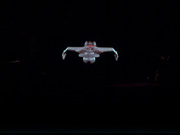 |
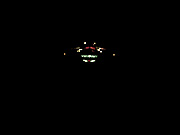 |
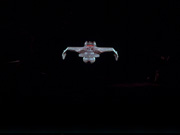 |
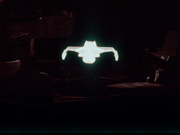 |
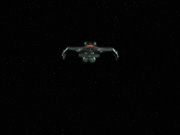 |
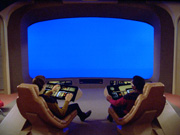 |
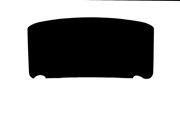 |
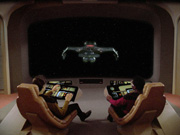 |
|
| A full breakdown of the blue screen keying process which is used for blue screen shots such as this bridge viewscreen shot, from effect 058 on episode 20, ‘Heart of Glory‘ | ||
Craig Weiss: Some of the things we’re able to do now that we weren’t able to do back then is the way we handle the edges with blur and recreating grain and stuff that they couldn’t do. We’re able to get a much more like-for-like composite than they could back then. They really didn’t have the ability to finesse the edges and have all the different buttons to push that we do now.
Eric Bruno: We can pull out really really fine details, we can remove blue spill and green spill much more effectively and we can add interactive lighting on the edges of the mattes – on the edges of the hair, whatever objects we are keying, and really integrate them into the scene so that it’s virtually seamless. Obviously the technology back then was still emerging so they didn’t have the ability to do that.
TrekCore: With regards to the grain, it was such a refreshing change to see something which wasn’t digitally scrubbed away which has been the case in many cinematic blu-ray releases. Do you have to physically add the grain when you’re creating new digital effects? Does it have to be superimposed over the new effects?
Eric Bruno: Yes. Whenever there’s a digitally created object, whether it be [one of] Max’s matte paintings, or something from Niel and his team, we have to match the grain of the production footage. And we have to match it so it’s virtually identical so it has the exact same texture in both shots.
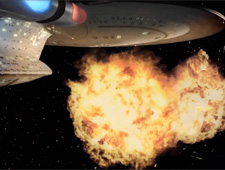 |
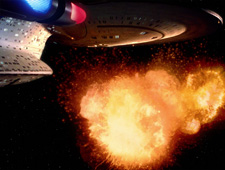 |
| The iconic scene of the Batris exploding from Season 1’s ‘Heart of Glory‘ appeared in the Season 1 blu-ray trailer. Craig Weiss explains that the explosion we saw in that trailer was just a temp (left), and was replaced with a far more authentic version in the final blu-ray release (right). | |
TrekCore: For Craig – what kind of artistic license do you have with this project? We understand the remit is very different from the Original Series remastering. For example, in the Season 1 trailer there is a ‘modern’-style explosion effect shown for the exploding Batris and then you went back closer to the original effects when the blu-rays came out and toned it down. Are these artistic choices on your part, or is it Mike & Denise’s comments taking effect?
Craig Weiss: The actual explosion that you saw was a temp, because at that time we didn’t have the actual explosion. Hence the difference with what made it back into the blu-ray. But just philosophically speaking about this project, unlike the Original Series where a lot of the original elements had to be recreated because they didn’t exist and wouldn’t hold up, everything in this project is blueprinted and shot on film. Every ship shot, every layer… so it was really the goal to not just make this an extraordinary picture in terms of quality, but to stay faithful to the original show and to the details. There are certain things that have been changed here and there where there were probably mistakes back then, and they didn’t catch them. We have the ability to go back in and, again – the goal is to keep it the same but make it better where we can without changing the artistic integrity. So, we’ve been extremely faithful because we felt that’s what this deserved and [that the show] was really kind of perfect from the beginning. We just wanted to bring it to a level of quality that really blew people away.

